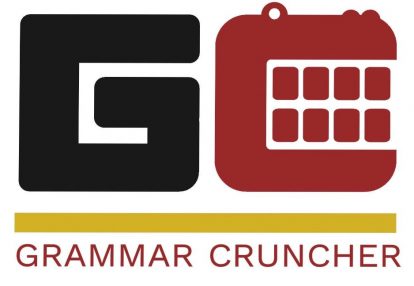The Grammar Cruncher Online Language Learning Application

(*As of Fall 2022 the Grammar Cruncher was incorporated into the GER 1125 & GER 1126 “Discover German” Online Beginning German sequence. Here is a link to the public preview of GER 1125: https://ufl.instructure.com/courses/463104. Here is a link to concept and use of the Grammar Cruncher as set forth in this course: https://ufl.instructure.com/courses/463104/pages/grammar-cruncher-user-directions-and-concept)
Besides the more practical pedagogical functions described below, the Grammar Cruncher also tries to begin to address the questions posed in the last paragraph of this passage:
“Language is the tool, the techné, which the speaking subject uses in order to exist in a world, to dwell in it and to continue to construct it as human…
The word seems the treasure of language, the word in its nominative function. The fact that the verb is the word par excellence insofar as it creates a link, a state, a world … is not emphasized. The verb as acting on the world, the other, the subject, is not analyzed in its complexity.
Its operation of designation, denomination, monstration, is privileged so as to supplant and to cause the forgetting of other possible actions. The verb disappears, fades away, is forgotten in the substantive. Speaking then loses a large part of its creative function in the present. Only the monstration remains, in which man appropriates himself to a linguistic role which limits his identity without totally opening it up…
If man is the animal endowed with language, who could imagine that this property serves simply to express his needs and to name the objects of his world? Does not language have to serve for transforming instincts and needs into shared desires?”
Luce Irigaray, The Way of Love (New York: Continuum, 2002), 38-39.
—
Click for Language Cruncher (German iteration) Instructional Video (6:44):
The German Grammar Cruncher is a drag-and-drop online language learning application being developed in collaboration with UF IT Web Services (specifically, Matthew Mckee, Darius Rodriguez, Danny Aguilar, Saharath Noisuwan, and Michael Merrit). It is designed to be a flexible online workspace in which students can drag words and phrases from a vocabulary list or passage at the top of the page and drop them into definable “Positions” presenting themselves at the bottom of the page where they can be edited as needed. The GC has three interconnected goals:
Goal #1 is to develop and cultivate an online space between translations, grammatical structures, and cultural information on one end and “natural language use” on the other end of an idealized language spectrum.
Goal #2 is to develop and cultivate this online space practically as a pedagogically sound and easily usable language learning tool for online language learning platforms. The drag and drop principle makes language learning “hands-on.” Students are encouraged to practice language agency by considering the language they build in the online space their own.
Goal #3 is to cultivate this online space theoretically as one in which language comes to be understood and employed as combinatory relations among: 1) actions (verbs and verbal constructions), actors (doers, direct and indirect recipients, and other stakeholders in/of an action), and interactive (symbolic/literal) and transactive (metaphoric/figurative) modalities involving temporal, causal, and spatial relations; and 2) sentence positions that can be differently occupied, but in way that must “true” —according to this word’s verbal sense of making “level, square, balanced, or concentric” or bringing or restoring “to a desired mechanical accuracy or form.”
Link to overview of adding a word to the GC dictionary via the Instructor Dashboard.
Link to overview of creating a GC Passage Work assignment via the Instructor Dashboard.
Link to overview of using the GC to do a Vocabulary Work assignment via the Student Portal.
Link to overview of using the GC to do a Passage Work assignment via the Student Portal.
—
The Positions are as few or many as needed and definable according to instructor goals. Here’s an example with eight positions making space for: 1) a “Doer”; 2) action; 3) a “Done-unto-directly”; 4) “Done-to-or-for-indirectly”; 5) a temporal modality ; 6) a causal modality; 7) a local modality; and 8) a sentence final position earmarked for completion of the action.
Position #1 Help Text:
either 1. [“Ja,” or “Nein,” inserted at the beginning in response to a yes/no-question have no effect on this or the below positions] Position 1: either “Doer” of the action (nominative subject); or “Done-unto-directly” of the action (accusative direct object); or “Done-to-or-for-indirectly” of the action (dative indirect object); or an Adverbial Modifier of time, causality/circumstance, or place (preferably in this order). [Here and elsewhere: a Stakeholder/Possessor in/of an action can be appended to a doer, recipient, or modifier via a genitive construction.]
Position #2 Help Text:
The ACTION: a verb in its conjugated form agreeing in gender, number, and person with the Subject/”Doer” of the action. This may ALSO be a sentence final position in the simplest possible subject-verb construction; any of the following below might also be sentence final.]
Position #3 Help Text:
either “Doer” of the action (nominative subject, if inverted); or “Done-Unto” of the action (accusative direct object); or “Done-to-or-for-indirectly” of the action (dative indirect object); or an Adverbial Modifier of time, causality/circumstance, or place (preferably in this order).
Position #4 Help Text:
either “Doer” of the action (nominative subject, if inverted and then further bumped, in very rare cases); or “Done-Unto” of the action (accusative direct object); or “Done-to-or-for-indirectly” of the action (dative indirect object); or an Adverbial Modifier of time, causality/circumstance, or place (preferably in this order).
Position #5 Help Text:
either “Done-Unto” of the action (accusative direct object); or “Done-to-or-for-indirectly” of the action (dative indirect object); or an Adverbial Modifier of time, causality/circumstance, or place (preferably in this order).
Position #6 Help Text:
either “Done-Unto” of the action (accusative direct object); or “Done-to-or-for-indirectly” of the action (dative indirect object); or an Adverbial Modifier of time, causality/circumstance, or place (preferably in this order).
Position #7 Help Text:
either “Done-Unto” of the action (accusative direct object); or “Done-to-or-for-indirectly” of the action (dative indirect object); or an Adverbial Modifier of time, causality/circumstance, or place (preferably in this order).
Position #8 Help Text:
A Sentence Final Position consisting of some kind of completion of the action/predicate: past participle, modal verb, predicate nominative, prepositional complement, some other completion of the action/predicate.
—
For feedback or ideas about languages to crunch besides German, contact Will Hasty hasty@ufl.edu. A Grammar Cruncher logo without “German” in it:


